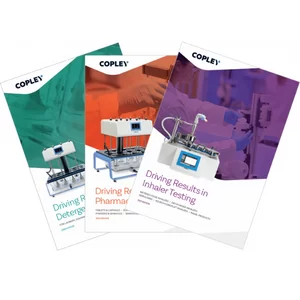Automating key aspects of inhaler testing can deliver great rewards. Find out how to reap the benefits.
When manually shaking solvent in an induction port or DUSA tube, or coating collection cups, it’s easy to think: There must be a better way. And there is.
Automation can simultaneously improve data quality, productivity, and analyst motivation thereby delivering a healthy return on investment. Use our tips for success to help you to access these gains while minimising risk.
Target areas prone to variability, such as time consuming and repetitive tasks
The specificity of inhaler test methods makes fully automating the end-to-end process, either with a one-size-fits all approach or a bespoke product-specific solution, prohibitively expensive and complex. This is especially true for the cascade impaction methods used for aerodynamic particle size distribution (APSD) measurement. Eliminating repetitive, time-consuming tasks that are common across all methods is the most practical and efficient solution. This ‘semi-automation’ as it is often called is both flexible and low risk.
So, where to start? Firstly, consider whether there are specific tasks that are known to be problematic. Is there a compendial requirement? Are any tasks leading to significant variability in the data? Or especially tedious and time-consuming? Generally, device actuation and drug recovery processes are both primary targets.
Device actuation
Automating device actuation is common for nasal sprays, nasal aerosols and metered dose inhalers (MDIs). Indeed, it may be essential. Compendial specifications point to the benefits with respect to reproducibility and stipulate the use of a ‘mechanical means’ of actuation for delivered dose uniformity testing for nasal sprays and aerosols. For MDIs, the arduous nature of, for example, delivered dose uniformity testing over the entire unit life provides compelling motivation. An automated shake, fire and flow control platform controls shaking speed, angle, and duration, actuation profile, and a range of other relevant parameters for robust consistency.
Drug recovery
The drug recovery processes associated with inhaler testing, notably cascade impaction, involve the rigorous rinsing of multiple pieces of equipment with known volumes of solvent. These are tasks ripe for automation, and some of the associated tools are relatively inexpensive. For example, investing in a unit that reproducibly agitates solvent in induction ports and preseparators is an accessible first step. It’s a simple switch that can provide more reproducible drug recovery while simultaneously benefiting analyst workflows. Reduced risk of repetitive strain injury (RSI) is an important further benefit, particularly for the relatively larger and heavier preseparator.
Other somewhat similar tasks amenable to automation include:
- Cup coating
- Dose Uniformity Sampling Apparatus (DUSA) shaking
- Solvent dispensing into impactor collection cups/plates and subsequent agitation
- Impactor cleaning
Implement off-the-shelf equipment that can be scaled with capacity requirements and replicated across locations
While the challenge of in-house or custom-built automation may be a tempting engineering project, the more dependable option is undoubtedly off-the-shelf solutions.
The advantages include:
- Proven, readily validated designs
- Ease of use
- Demonstrable reliability and maintenance requirements, with ongoing support as required
Judicious investments in automation call for the careful consideration of current requirements within the context of product lifespan. Simple, off-the-shelf solutions are sufficiently low cost for use to begin in product development. If the product is unsuccessful, then equipment can simply be transferred to the next candidate. Alternatively, for a promising drug, investing in duplicate systems and running them in parallel is an easy way to rapidly increase testing capacity. Off-the-shelf solutions facilitate this approach.
Look for solutions that align to ease validation and ensure reproducibility
Since automation opportunities extend from equipment preparation through testing to sample recovery a single supplier with a holistic portfolio is appealing. New investment doesn’t negate previous spend when solutions are designed to work together, and familiarity can ease training and day-to-day use.
In addition, certain commercial automation products belong to the same ‘family’ essentially forming a suite for progressive automation.
For example, our Vertus® family of automated shake and fire platforms share the same arc-like shaking motion. This allows for the direct transfer of Vertus methods for firing to dose collection to DecaVertus® for firing-to-waste.
Similarly, the Impactor Genie™ IG 200i offers an identical agitation motion to the Gentle Rocker™ streamlining transfer between the two.
Such solutions can make a substantial difference when it comes to progressive automation and scale-up. Operational comparability lightens the validation workload while simultaneously assuring a rapid switchback to manual, if necessary. Investment can therefore be commensurate with product progress towards commercialisation, ensuring quicker cycles times with minimal risk.
Rigorously assess gains to justify further investment
Modern labs face intense cost pressures and the rigorous scrutiny of any capital requests. Against this background starting small makes sense and pursuing a stepwise approach can really help. An initial, relatively inexpensive project can provide evidence to justify subsequent spend by helping to answer questions such as:
- Have we found a reliable supplier that can deliver the solutions we need to automate in a way that aligns with our CAPEX flow and appetite for risk?
- How easy is it to validate automation solutions and bring them into routine use?
- What kind of reliability have we seen? And what levels of usage?
- Can we see any improvement in data quality?
- Can we see any improvement in analyst motivation?
- Is it possible to determine, and monetise the time saved?
This last point potentially provides the most compelling evidence for further investment. Evidence from our customers suggests automation can deliver productivity gains ranging from a 30% per analysis time saving to a tripling of per analyst productivity. Such significant economic gains indicate that automation can deliver an extremely healthy return on investment. Ensuring you have a robust baseline and rigorously assess all benefits is the key to reliable economic evaluation.
In conclusion
In inhaler testing, automation can simultaneously improve data quality, increase productivity, and enhance analyst motivation. This win-win (-win) makes investment worthy of serious consideration. That said, not all solutions are equally effective in delivering a high rate of return. Relevance and reliability are critical, so too is ease-of use, from validation to day-to-day operation. To explore our expertise and experience read our published article or talk to one of our application specialists. Expert advice can be invaluable when it comes to investing budget wisely.








